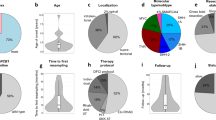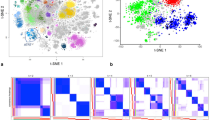Abstract
Multifocal synchronous or metachronous atypical teratoid rhabdoid tumors (ATRTs) and non-central nervous system malignant rhabdoid tumors (extra-CNS MRTs) are rare cancers. We reviewed the clinical and radiologic characteristics of affected patients seen at our institution. Genotyping and analysis of copy number abnormalities (CNAs) in SMARCB1 were performed in germline and tumor samples. Tumor samples underwent genome-wide DNA methylation and CNA analysis. The median age at diagnosis of 21 patients was 0.6 years. Two-thirds of ATRTs and extra-CNS MRTs were diagnosed synchronously. Although kidney tumors predominated, including two patients with bilateral involvement, at least 30% of cases lacked renal involvement. Histopathologic review confirmed MRTs in all cases and INI1 expression loss in all tumors tested. Fourteen (78%) of 18 patients tested had heterozygous germline SMARCB1 abnormalities. At least one allelic SMARCB1 abnormality was confirmed in 81 and 88% of ATRTs and extra-CNS MRTs, respectively. Unsupervised hierarchical clustering analysis of DNA methylation in 27 tumors and comparison with a reference group of 150 ATRTs classified the CNS tumors (n = 14) as sonic hedgehog (64%), tyrosinase (21%), and MYC (14%). The MYC subgroup accounted for 85% of 13 extra-CNS MRTs. Of 16 paired ATRTs and extra-CNS MRTs, the tumors in seven of eight patients showed a different pattern of genome-wide DNA methylation and/or CNAs suggestive of non-clonal origin. CNS and extra-CNS tumors had an identical SMARCB1 amplification (n = 1) or very similar DNA methylation pattern (n = 1) suggestive of clonal origin. All patients died of tumor progression. The clinical and molecular characteristics of multifocal ATRTs and extra-CNS MRTs are heterogeneous with most patients harboring a cancer predisposition. Although independent tumor origin was confirmed in most cases, metastatic spread was also documented. The recognition of their distinct molecular characteristics is critical in selecting new biologic therapies against these deadly cancers.



Similar content being viewed by others
References
Aryee MJ, Jaffe AE, Corrada-Bravo H, Ladd-Acosta C, Feinberg AP, Hansen KD, Irizarry RA (2014) Minfi: a flexible and comprehensive Bioconductor package for the analysis of Infinium DNA methylation microarrays. Bioinformatics 30:1363–1369. https://doi.org/10.1093/bioinformatics/btu049
Beckwith JB, Palmer NF (1978) Histopathology and prognosis of Wilms tumor: results from the First National Wilms’ Tumor Study. Cancer 41:1937–1948. https://doi.org/10.1002/1097-0142(197805)41:5<1937::aid-cncr2820410538>3.0.co;2-u
Biegel JA, Zhou JY, Rorke LB, Stenstrom C, Wainwright LM, Fogelgren B (1999) Germ-line and acquired mutations of INI1 in atypical teratoid and rhabdoid tumors. Cancer Res 59:74–79
Biegel JA, Fogelgren B, Wainwright LM, Zhou JY, Bevan H, Rorke LB (2000) Germline INI1 mutation in a patient with a central nervous system atypical teratoid tumor and renal rhabdoid tumor. Genes Chromosom Cancer 28:31–37. https://doi.org/10.1002/(sici)1098-2264(200005)28:1<31::aid-gcc4>3.0.co;2-y
Biegel JA, Tan L, Zhang F, Wainwright L, Russo P, Rorke LB (2002) Alterations of the hSNF5/INI1 gene in central nervous system atypical teratoid/rhabdoid tumors and renal and extrarenal rhabdoid tumors. Clin Cancer Res 8:3461–3467
Biggs PJ, Garen PD, Powers JM, Garvin AJ (1987) Malignant rhabdoid tumor of the central nervous system. Hum Pathol 18:332–337. https://doi.org/10.1016/S0046-8177(87)80161-2
Birks DK, Donson AM, Patel PR, Sufit A, Algar EM, Dunham C, Kleinschmidt-DeMasters BK, Handler MH, Vibhakar R, Foreman NK (2013) Pediatric rhabdoid tumors of kidney and brain show many differences in gene expression but share dysregulation of cell cycle and epigenetic effector genes. Pediatr Blood Cancer 60:1095–1102. https://doi.org/10.1002/pbc.24481
Bonnin JM, Rubinstein LJ, Palmer NF, Beckwith JB (1984) The association of embryonal tumors originating in the kidney and in the brain. A report of seven cases. Cancer 54:2137–2146. https://doi.org/10.1002/1097-0142(19841115)54:10<2137::aid-cncr2820541014>3.0.co;2-d
Bourdeaut F, Lequin D, Brugières L et al (2011) Frequent hSNF5/INI1 germline mutations in patients with rhabdoid tumor. Clin Cancer Res 17:31–38. https://doi.org/10.1158/1078-0432.CCR-10-1795
Chun HJ, Lim EL, Heravi-Moussavi A et al (2016) Genome-wide profiles of extra-cranial malignant rhabdoid tumors reveal heterogeneity and dysregulated developmental pathways. Cancer Cell 29:394–406. https://doi.org/10.1016/j.ccell.2016.02.009
Eaton KW, Tooke LS, Wainwright LM, Judkins AR, Biegel JA (2011) Spectrum of SMARCB1/INI1 mutations in familial and sporadic rhabdoid tumors. Pediatr Blood Cancer 56:7–15. https://doi.org/10.1002/pbc.22831
Fort DW, Tonk VS, Tomlinson GE, Timmons CF, Schneider NR (1994) Rhabdoid tumor of the kidney with primitive neuroectodermal tumor of the central nervous system: associated tumors with different histologic, cytogenetic, and molecular findings. Genes Chromosom Cancer 11:146–152. https://doi.org/10.1002/gcc.2870110303
Foulkes WD, Kamihara J, Evans DGR, Brugières L, Bourdeaut F, Molenaar JJ, Walsh MF, Brodeur GM, Diller L (2017) Cancer surveillance in Gorlin syndrome and rhabdoid tumor predisposition syndrome. Clin Cancer Res 23:e62–e67. https://doi.org/10.1158/1078-0432.CCR-17-0595
Fujita M, Sato M, Nakamura M et al (2005) Multicentric atypical teratoid/rhabdoid tumors occurring in the eye and fourth ventricle of an infant: case report. J Neurosurg 102:299–302
Giunti L, Bernini G, Forni M, Tucci F, Wheeler E, Sardi I (2006) Clonality analysis of pediatric multiple tumors: two case reports and laboratory investigation. J Pediatr Hematol Oncol 28:241–248. https://doi.org/10.1097/01.mph.0000212909.91770.72
Hasselblatt M, Isken S, Linge A et al (2013) High-resolution genomic analysis suggests the absence of recurrent genomic alterations other than SMARCB1 aberrations in atypical teratoid/rhabdoid tumors. Genes Chromosom Cancer 52:185–190. https://doi.org/10.1002/gcc.22018
Hasselblatt M, Nagel I, Oyen F et al (2014) SMARCA4-mutated atypical teratoid/rhabdoid tumors are associated with inherited germline alterations and poor prognosis. Acta Neuropathol 128:453–456. https://doi.org/10.1007/s00401-014-1323-x
Hovestadt V, Zapatka M (2015) conumee: enhanced copy-number variation analysis using Illumina 450k methylation arrays. R package version 0.99.4. In: Bioconductor: open source software for bioinformatics. http://www.bioconductor.org/packages/release/bioc/html/conumee.html
Jackson EM, Sievert AJ, Gai X, Hakonarson H, Judkins AR, Tooke L, Perin JC, Xie H, Shaikh TH, Biegel JA (2009) Genomic analysis using high-density single nucleotide polymorphism-based oligonucleotide arrays and multiplex ligation-dependent probe amplification provides a comprehensive analysis of INI1/SMARCB1 in malignant rhabdoid tumors. Clin Cancer Res 15:1923–1930. https://doi.org/10.1158/1078-0432.CCR-08-2091
Johann PD, Erkek S, Zapatka M et al (2016) Atypical teratoid/rhabdoid tumors are comprised of three epigenetic subgroups with distinct enhancer landscapes. Cancer Cell 29:379–393. https://doi.org/10.1016/j.ccell.2016.02.001
Kordes U, Gesk S, Frühwald MC et al (2010) Clinical and molecular features in patients with atypical teratoid rhabdoid tumor or malignant rhabdoid tumor. Genes Chromosom Cancer 49:176–181. https://doi.org/10.1002/gcc.20729
Kusafuka T, Miao J, Yoneda A, Kuroda S, Fukuzawa M (2004) Novel germ-line deletion of SNF5/INI1/SMARCB1 gene in neonate presenting with congenital malignant rhabdoid tumor of kidney and brain primitive neuroectodermal tumor. Genes Chromosom Cancer 40:133–139. https://doi.org/10.1002/gcc.20026
Lee RS, Stewart C, Carter SL et al (2012) A remarkably simple genome underlies highly malignant pediatric rhabdoid cancers. J Clin Invest 122:2983–2988. https://doi.org/10.1172/JCI64400
Parham DM, Weeks DA, Beckwith JB (1994) The clinicopathologic spectrum of putative extrarenal rhabdoid tumors. An analysis of 42 cases studied with immunohistochemistry or electron microscopy. Am J Surg Pathol 18:1010–1029
R Core Team (2015) R: a language and environment for statistical computing. R Foundation for Statistical Computing, Vienna, Austria. http://www.R-project.org
Rorke LB, Packer RJ, Biegel JA (1996) Central nervous system atypical teratoid/rhabdoid tumors of infancy and childhood: definition of an entity. J Neurosurg 85:56–65
Savla J, Chen TT, Schneider NR, Timmons CF, Delattre O, Tomlinson GE (2000) Mutations of the hSNF5/INI1 gene in renal rhabdoid tumors with second primary brain tumors. J Natl Cancer Inst 92:648–650. https://doi.org/10.1093/jnci/92.8.648
Sévenet N, Sheridan E, Amram D, Schneider P, Handgretinger R, Delattre O (1999) Constitutional mutations of the hSNF5/INI1 gene predispose to a variety of cancers. Am J Hum Genet 65:1342–1348. https://doi.org/10.1086/302639
Tauziède-Espariat A, Masliah-Planchon J, Brugières L et al (2017) Deep intronic hotspot variant unraveling rhabdoid tumor predisposition syndrome in two patients with atypical teratoid and rhabdoid tumor. Eur J Hum Genet. https://doi.org/10.1038/ejhg.2017.115 (in press)
Tomlinson GE, Breslow NE, Dome J et al (2005) Rhabdoid tumor of the kidney in the National Wilms’ Tumor Study: age at diagnosis as a prognostic factor. J Clin Oncol 23:7641–7645. https://doi.org/10.1200/JCO.2004.00.8110
Torchia J, Picard D, Lafay-Cousin L et al (2015) Molecular subgroups of atypical teratoid rhabdoid tumours in children: an integrated genomic and clinicopathological analysis. Lancet Oncol 16:569–582. https://doi.org/10.1016/S1470-2045(15)70114-2
Versteege I, Sévenet N, Lange J, Rousseau-Merck MF, Ambros P, Handgretinger R, Aurias A, Delattre O (1998) Truncating mutations of hSNF5/INI1 in aggressive paediatric cancer. Nature 394:203–206. https://doi.org/10.1038/28212
Weeks DA, Beckwith JB, Mierau GW, Luckey DW (1989) Rhabdoid tumor of kidney. A report of 111 cases from the National Wilms’ Tumor Study Pathology Center. Am J Surg Pathol 13:439–458. https://doi.org/10.1097/00000478-198906000-00001
Acknowledgements
This work was supported by the United States National Institutes of Health Cancer Center Support (CORE) Grant P30 CA21765 and by the American Lebanese Syrian Associated Charities (ALSAC). We thank Geoffrey Neale, PhD and Emily Walker for assistance in performing the DNA methylation studies.
Author information
Authors and Affiliations
Corresponding author
Electronic supplementary material
Below is the link to the electronic supplementary material.
Online Resource 1
Primers and conditions used to sequence SMARCB1 (DOCX 26 kb)
Online Resource 2
Raw data of chromosomal gains and losses in 27 multifocal synchronous or metachronous tumors. Areas of copy gain are highlighted in red and those of copy loss in yellow. Light blue stripes across tumors outline recurrent areas of gains or losses in at least three tumors. While a cutoff of -0.2 or lower was considered an area of chromosomal loss, +0.2 or higher values represented areas of chromosomal gains (XLSX 485 kb)
Online Resource 3
Coronal computed tomography without contrast showing bilateral kidney involvement in patient 14 (TIFF 2020 kb)
Online Resource 4
Coronal T2-weighted magnetic resonance imaging showing pedunculated bladder mass in patient 16 (TIFF 2020 kb)
Online Resource 5
Bladder mass observed during cystoscopy in patient 16 (TIFF 316 kb)
Rights and permissions
About this article
Cite this article
Pinto, E.M., Hamideh, D., Bahrami, A. et al. Malignant rhabdoid tumors originating within and outside the central nervous system are clinically and molecularly heterogeneous. Acta Neuropathol 136, 315–326 (2018). https://doi.org/10.1007/s00401-018-1814-2
Received:
Revised:
Accepted:
Published:
Issue Date:
DOI: https://doi.org/10.1007/s00401-018-1814-2




